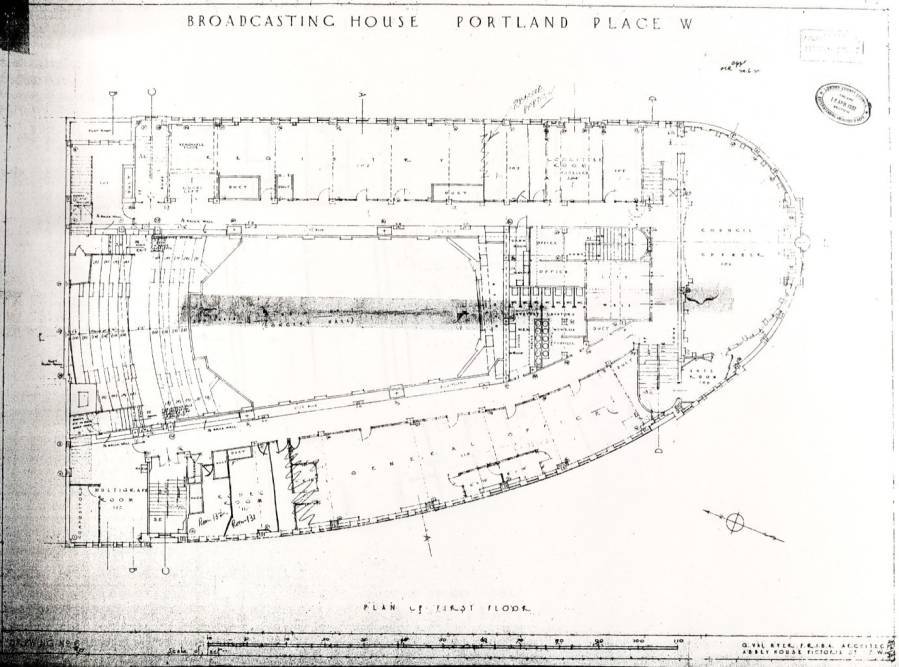Ravensbourne's Room 101
Nineteen Eighty-Four, George Orwell's influential masterpiece, turns 73 years old this week. Here, Ravensbourne Digital TV Production lecturer Guy Saich explores its history, and the origins of its infamous Room 101.
Having recently joined the teaching team at Ravensbourne, I sat one lunchtime on the first floor eating my lunch. Looking around, I noticed the ominous three digits of the room number on a pillar: 101.
Over the years, I have written extensively about George Orwell and especially the BBC’s Broadcasting House. I thought I would put pen to paper (well, OK, Microsoft Word!) and explain where Room 101 originated from and what it actually means.
To the TV audience, Room 101 is a light-hearted chat show, where participants would confine their pet hates to Room 101. All very tame compared to George Orwell’s dystopian masterpiece of 'Nineteen Eighty-Four', where Room 101 is the torture chamber.
Nineteen Eighty-Four was first published in the UK 73 years ago on 8 June 1949. The book follows Winston Smith, a low-ranking member of 'The Party', in the nation of Oceania. The Party watches his every movement through telescreens and controls everyone’s history and even their language, with Big Brother controlling every aspect of people's lives.
Towards the end of Nineteen Eighty-Four, Winston is sent to torture chamber in the basement at the Ministry of Love where he is tortured and then brainwashed. In Room 101 he has to confront his worst nightmare: Rats.
Room 101
The thing that is in Room 101 is the worst thing in the world.”
BBC Broadcasting House

There has been much scholarly conjecture about the origin of Room 101. First and foremost, there was a Room 101 in the original BBC’s 1932 Art Deco Broadcasting House (see the top left of the plan above). It was a humble office situated on the on the north-east corner on the first floor of the building. At that time devoted to sorting mail and clerical work such as typing and filing.
George Orwell worked for the BBC between 18 August 1941 and 24 November 1943, as a talks assistant for the Eastern Service, later moving to become a producer for the BBC’s Indian Section.
During most of his time at the BBC, Orwell’s desk was located not at Broadcasting House, but in the basement of number 200 Oxford Street, which at that time was Peter Robinson’s department store. Orwell’s experience of his basement office would later be portrayed as Winston Smith’s desk in Nineteen Eighty-Four.
At the age of 38, Orwell became a talks assistant in the BBC’s Overseas Empire Department, which had moved to number 55 Portland Place, located just 300 metres from Broadcasting House. That building still stands today.
There is another school of thought that Room 101 was not situated at Broadcasting House, or even at number 55 Portland Place, but in Eastbourne, at Orwell’s former school, St Cyprian's. Yet another thought was that Orwell based Room 101 on his former headmaster’s study.
On 21 January 1950, at the age of 47, George Orwell died of tuberculosis, just seven months after Nineteen Eighty-Four was published.
Many of his phrases are still in use in the English language today, such as: 'Big Brother is watching you', 'Newspeak', 'Thought Police', 'Proles', and 'Doublethink'. Orwell was one of the people who first used the phrase: 'Cold War', in his 1945 essay: 'You and the Atom Bomb', written during World War II, just two months after the Hiroshima and Nagasaki atomic bombs.
I visited Room 101 just before the original Art Deco Broadcasting House was closed for refurbishment. At that time, it was being used as a plant room with various silver insulated pipes coming out of the walls. Not quite Terry Gilliam’s vision in his 1985 film, “Brazil.” But this is the Room 101? Or was it? Film critics have made comparisons between Orwell’s vision of the future and Gilliam’s nod to the book.
I would like to offer my own short and humble conclusion to the mystery of Room 101. I think that Orwell, encountered a number of experiences during his time at school and at the BBC. Together, these experiences were woven into the tapestry of Nineteen Eighty-Four and the horror of Room 101.
Guy Saich - Lecturer, BA (Hons) Digital Television Production
Guy’s historical research of Broadcasting House was used as part of the BBC’s planning application to redevelop the ‘New’ Broadcasting House and was extensively used in Mark Hines publication: The Story of Broadcasting House – Home of the BBC.



